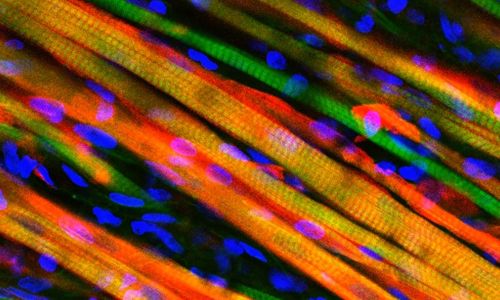Biomedical engineers have finally achieved success in growing skeletal muscle under a laboratory conditions. These laboratory grown muscles, similar to real muscle are capable of contracting and expanding quickly. Most important breakthrough in the research is that the muscles when implanted in mice were capable of healing itself from any injuries, which was not possible till now.
The biomedical engineers in the lab of the Duke University created an ideal environment for the growth of the muscle, which required muscles fibers; well developed and contractile and a pool of satellite cells (immature stem cells) which would grow into muscle tissue. These satellite cells act as reserves and are found abundantly in every muscle, ready for healing any damage caused to muscles. The biggest challenge faced by the team was to create a perfect microenvironments, termed as niches, where wait till they are required for repair.
The in vitro muscles were strong, aptly contractile and above all, when the toxin from snake caused injuries to these muscles, satellite cells successfully accomplished regeneration by stimulating, multiplying and healing injured muscle. The team grafted these muscles into mice and found that the muscle easily integrated with the other surrounding tissue and were also performing their job well.
To monitor the real time growth and progress, research team along with Greg palmer who is an assistant professor of radiation oncology in the Duke University School of Medicine, the muscle grown in the laboratory was implanted into a small cavity created on the back of the mice. The glass panel covered the cavity by which the team imaged and monitored the progress of the muscle inside the mouse body. They observed blood vessels growing and extending into the implanted bioengineered muscle fibers which slowly mature and become as strong as its native counterpart. The bioengineered muscle implants can survive if they are supplied with oxygen-rich blood through the body’s blood vessels.
However, the team says more study and tests need to be carried out before they can try develop similar muscle in humans. Researchers Nenad Bursac leading the study said the muscle created in the laboratory is an important advancement as this the first time that engineered muscle is so tough and capable of contacting as well as native neonatal skeletal muscle.
As per Prof Mark Lewis from Loughborough University and a specialist in skeletal muscle tissue engineering said many research works were able to create muscle in laboratory that functioned similar to muscles in humans. But never before, these muscles when grafted in living creatures were able to function as neonatal skeletal muscle and taken the science to an another level.
Such research brings new hope for the stem cell science that are capable of converting into any tissue type and will now remold regenerative medicine. Researchers have already accomplished creating mini livers and kidneys using stem cells in the laboratory. They are also trying to use stem cells in repairing heart muscle. For conducting experiments on mice, researchers have a substantial pool of stem cell available, however, for humans, comparatively only a small quantity of stem cells are available which are difficult to manage as they tend to lose their potency. But successful implementation in humans for advanced treatment will still few years of research.
Source: Scicasts




